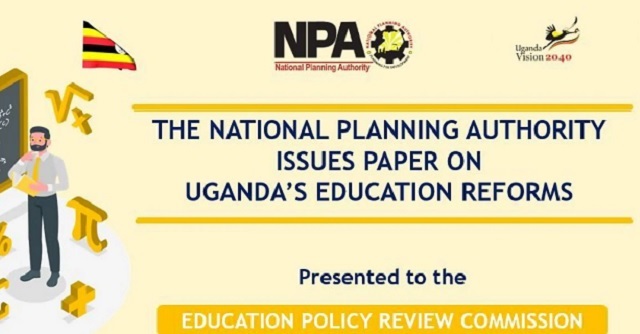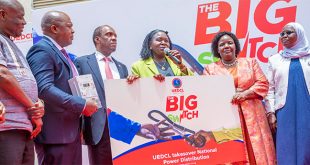
Kampala, Uganda | THE INDEPENDENT | The National Planning Authority (NPA) has put forward new, radical suggestions in the midst of the ongoing debate surrounding the ever-increasing fees and related charges, more so in public and government-aided schools.
The National Planning Authority, responsible for advising the government on policies for the country’s development, suggests that any fees collected in public and government-aided schools, where the collection of fees is permitted by the government, should be deposited into the consolidated fund.
“All fees and charges by any public education and training institution should be remitted to the consolidated fund and never should there be spending at source without an approved budget,” the NPA issues paper on Uganda’s education reforms reads in part.
The aforementioned proposal is one of many submitted by the authority to the Nuwe Amanya Mushega-led Education Policy Review Commission, which has been tasked with revamping the country’s education system and charting a new course for it.
Collecting all fee payments through a government account is not a new concept. This system was already introduced in public universities in 2019, after it was discovered that some fees were being misused (stolen). The decision to collect fees through a single account managed by Uganda Revenue Authority was made to minimize such abuse.
The suggestion to extend the system to other institutions comes at a time of accusations mount of collecting fees that are not being used within the schools and the Education Ministry has proposed school fees regulations as a solution to the school fees problem. One aspect of the draft guideline includes regular audits of all fees collected by schools to ensure that all charges imposed are related to teaching and learning activities.
According to NPA’s paper, if the said proposal is effected, every public education and training institution should be obligated to maintain a single official bank account. Additionally, the authority also proposes that the government restrict public education institutions from incurring debt unless approved by the relevant authorities.
Notably from the proposal, NPA acknowledges that some schools, mainly in urban and wealthy areas, should be allowed to collect allowable fees and charges from learners. The determination of these schools is not specified, but the idea behind this is to effectively utilize the limited resources available.
Dr Hamis Mugendawala, the manager of Policy, Research and Innovation at NPA, notes that in an effort to make sure that rural and low-income communities also have unconstrained access to education, NPA is proposing to criminalize all fees in public and government-aided primary and secondary schools, particularly in areas where nomadic, conflict-ridden, and poverty-stricken communities reside.
Despite the focus on high-end schools whenever the school fees debate pops up, the 2017 Uganda National Housing Survey found that many children, particularly in rural areas, still cannot attend school or drop out due to the direct costs that parents bear.
NPA’s moderate scenario, which lies between the current state of affairs (scenario I) and the nearly impossible goal of providing completely free education (scenario III), recommends increasing the Capitation Grant per pupil per year to ensure that schools, more so for those which are restricted from asking for any fees from students, operate efficiently.
According to the issues paper, this would require the government to provide 38,773 shillings per learner per year at pre-primary and primary levels, 351,360 shillings at lower secondary, and UGX 570,220 at upper secondary. The NPA emphasizes that this funding should be primarily driven by enrollment, inflation, the wealth quintile of the school, and improved school performance such as completion, attendance, and transition rates. This is to ensure that the allocation of resources is aligned with the needs of the schools and learners.
Dr Mugendawala says that if their proposed funding model is implemented, it would result in increased government funding for schools in poor communities, thereby promoting equity and raising these schools to a higher level, closing the gap between the privileged and less privileged.
But, the issue paper also provides an option for the government to ban all charges in all public and government-aided schools. This scenario, referred to as Scenario III, would require a drastic increase in the capitation grant per pupil per year.
For primary schools, the grant would increase from 14,000 shillings to 63,546 shillings. At lower secondary, the capitation grant per student per year would increase from 170,000 shillings to 532,720 shillings, and at upper secondary, the capitation grant per student per year would increase from 255,000 shillings to 885,440 shillings.
Universal Primary Education (UPE) and Universal Secondary Education (USE) are supposed to be free in schools, however, some children still fail to access them due to additional charges such as uniforms, lunch, and PTA (Parents Teachers Association) fees. School authorities argue that the charges are necessary as the government provides insufficient funding for their schools, making it difficult to run the institutions effectively.
It should be noted that the National Resistance Movement (NRM) party promised to abolish all forms of charges in public schools during its 2021 campaign. The Ministry of Education also established a committee to gather data from the public on how to address the issue of fees in public schools. However, the matter has not been settled yet.
Education Minister Janet Kataaha Museveni recently commented on the matter while releasing the primary leaving examination results. She stated that the cabinet is currently reviewing the suggestions made by the Ministry of Education regarding school fees and related charges, including those in private schools. She asked the public to be patient and wait for the final verdict.
The draft regulations under the decision proposed by the Ministry include a ban on collecting school fees by all public and government-aided schools, with the exception of charges for allowable requirements, which have been capped at 430,000 Shillings.
Maximum fees for private high-end nursery schools, including allowable requirements, have been set at 690,000 Shillings. The proposed fees for primary day schools are 570,000 Shillings and 1.22 million Shillings for boarding primary schools. For secondary schools, day scholars are required to pay 960,000 Shillings while boarding students must pay 1.61 million Shillings.
Meanwhile, as an additional measure to increase access to primary education and control excessive school fees, especially in rural areas, researcher Mugendawala suggests that the government should consider implementing a school feeding program. He cites studies conducted in places like Karamoja, where the program has been established, as evidence of its positive impact.
The researcher acknowledges that the source of funding for the school feeding program is uncertain, but NPA has estimated that it might be archived at a unit daily cost of 1,220 shillings.
*****
URN
 The Independent Uganda: You get the Truth we Pay the Price
The Independent Uganda: You get the Truth we Pay the Price



